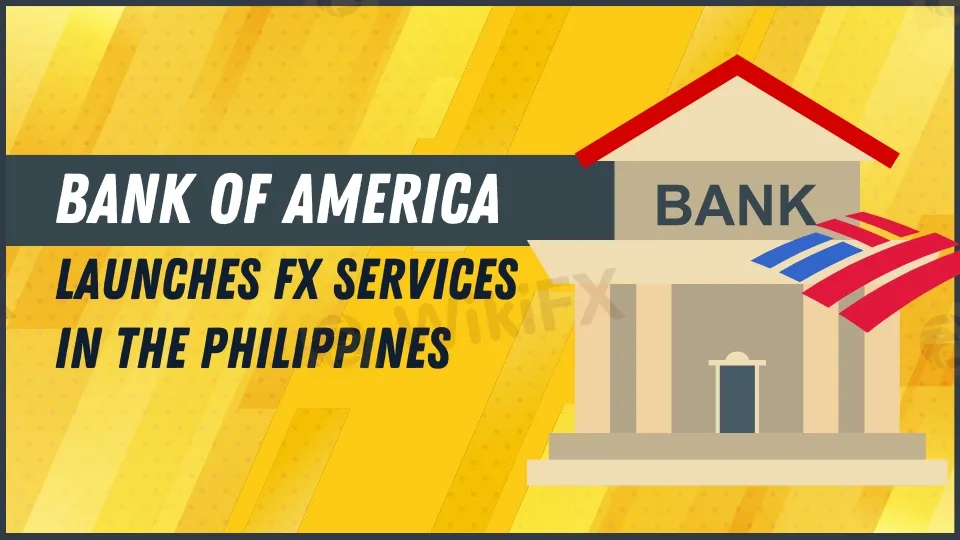简体中文
繁體中文
English
Pусский
日本語
ภาษาไทย
Tiếng Việt
Bahasa Indonesia
Español
हिन्दी
Filippiiniläinen
Français
Deutsch
Português
Türkçe
한국어
العربية
Bank of America Launches FX Services in the Philippines
Abstract:Bank of America begins foreign exchange (FX) services in the Philippines, eyeing a share of the $300 billion onshore currency market. Learn about their growth plans.

Bank of America Eyes $300B Philippine FX Market
Bank of America has formally re-entered the Philippine foreign exchange (FX) market, with ambitious intentions to capture a piece of the Southeast Asian country's estimated $300 billion annual onshore currency sector.
“We do think we will be able to get a pretty good market share of that,” said Shah Jahan Abu Thahir, head of Southeast Asia Global Markets at Bank of America. Thahir, who is based in Singapore, stressed the potential for the country's FX market to expand. “We expect the nation's foreign exchange business to grow substantially over the next few years due to structural tailwinds driving further investments in the Philippines,” according to him.
Investment Fuels Growth
The resurrection of Bank of America's FX operations coincides with an increase in investment from global enterprises, outsourcing firms, and semiconductor manufacturers in the Philippines. The bank's Philippine country head, Vince Valdepeñas, emphasized the increased need for foreign currency services in these businesses.

This is a notable return for the US-based lender, which formerly provided FX and fixed-income services in the Philippines until the early 2000s before focussing on the American market.
Expansion Beyond FX: Fixed-Income Business
Bank of America is also planning to open a fixed-income business in Manila, first targeting international corporations and huge local businesses. This offering will eventually be extended to financial institutions like asset managers and insurers.
Bank of America brings the Philippines into line with its operations in neighboring Southeast Asian countries such as Singapore, Thailand, Indonesia, and Malaysia by offering services in fixed income, currencies, and commodities.
Economic Tailwinds Support Growth
The Philippine economy expanded by 6.3% in the second quarter of this year, boosted by increased consumer spending and the central bank's shift to monetary easing.
We perceive that the Philippine economy is performing nicely. Valdepeñas emphasized that this is a long-term investment as market liquidity increases.
Final Thoughts
The return of Bank of America to the Philippine FX market reflects increased confidence in the country's economic potential. With rising investment prospects and a steady growth rate, the Philippines provides an ideal ground for global financial firms to develop. This expansion not only benefits local sectors but also meshes with the country's larger drive for increased financial integration in Southeast Asia.

Disclaimer:
The views in this article only represent the author's personal views, and do not constitute investment advice on this platform. This platform does not guarantee the accuracy, completeness and timeliness of the information in the article, and will not be liable for any loss caused by the use of or reliance on the information in the article.
Read more

RCBC and GCash Team Up to Offer Collateral-Free Loans
RCBC and GCash launch Pasado Loan for Filipinos. Borrow ₱30,000–₱500,000 with no collateral, low interest, and fast approval via GCash.

BlackRock Introduces Bitcoin ETF to Expand Crypto Investments in Canada
BlackRock launches iShares Bitcoin ETF on Cboe Canada (IBIT/IBIT.U), offering secure, cost-effective Bitcoin exposure for Canadian investors.

Italy’s Largest Bank Intesa Sanpaolo Enters Cryptocurrency Market
Intesa Sanpaolo buys €1M in Bitcoin, its first crypto move in Italy while still in debates about reducing crypto tax from 42% to 28%.

XRP Price Rises 5% Amid Positive ETF and SEC Developments
XRP price surges 5% with bullish ETF inflows, Ripple SEC updates, $2.90 resistance target, JP Morgan forecasts, and crypto donation efforts. Read the latest XRP news.
WikiFX Broker
Latest News
Wolf Capital Exposed: The $9.4M Crypto Ponzi Scheme that Lured Thousands with False Promises
Confirmed! US December non-farm payroll exceeded expectations
Spain plans 100% tax for homes bought by non-EU residents
90 Days, Rs.1800 Cr. Saved! MHA Reveals
The Yuan’s Struggle: How China Plans to Protect Its Economy
LiteForex Celebrates Its 20th Anniversary with a $1,000,000 Challenge
Misleading Bond Sales Practices: BMO Capital Markets Fined Again by SEC
Italy’s Largest Bank Intesa Sanpaolo Enters Cryptocurrency Market
400 Foreign Nationals Arrested in Crypto Scam Raid in Manila
Singapore Blocks Polymarket Access, Following U.S. and France
Currency Calculator






